Markus Lienkamp
Calibrating the Full Predictive Class Distribution of 3D Object Detectors for Autonomous Driving
Oct 02, 2025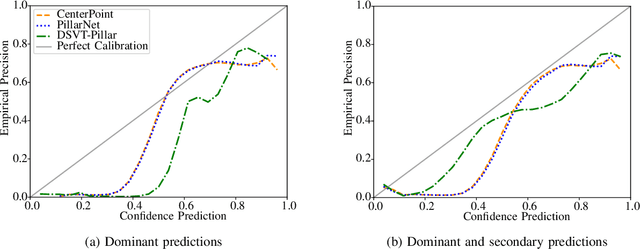


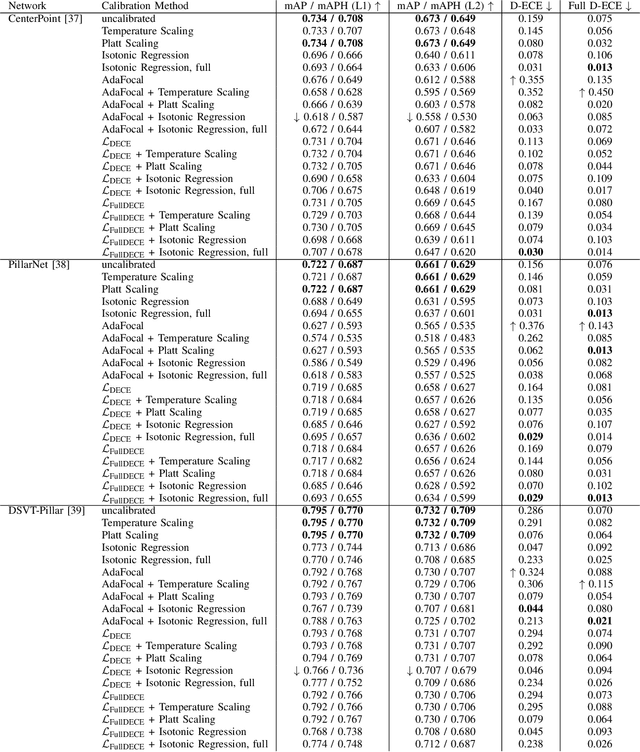
Abstract:In autonomous systems, precise object detection and uncertainty estimation are critical for self-aware and safe operation. This work addresses confidence calibration for the classification task of 3D object detectors. We argue that it is necessary to regard the calibration of the full predictive confidence distribution over all classes and deduce a metric which captures the calibration of dominant and secondary class predictions. We propose two auxiliary regularizing loss terms which introduce either calibration of the dominant prediction or the full prediction vector as a training goal. We evaluate a range of post-hoc and train-time methods for CenterPoint, PillarNet and DSVT-Pillar and find that combining our loss term, which regularizes for calibration of the full class prediction, and isotonic regression lead to the best calibration of CenterPoint and PillarNet with respect to both dominant and secondary class predictions. We further find that DSVT-Pillar can not be jointly calibrated for dominant and secondary predictions using the same method.
To New Beginnings: A Survey of Unified Perception in Autonomous Vehicle Software
Aug 28, 2025Abstract:Autonomous vehicle perception typically relies on modular pipelines that decompose the task into detection, tracking, and prediction. While interpretable, these pipelines suffer from error accumulation and limited inter-task synergy. Unified perception has emerged as a promising paradigm that integrates these sub-tasks within a shared architecture, potentially improving robustness, contextual reasoning, and efficiency while retaining interpretable outputs. In this survey, we provide a comprehensive overview of unified perception, introducing a holistic and systemic taxonomy that categorizes methods along task integration, tracking formulation, and representation flow. We define three paradigms -Early, Late, and Full Unified Perception- and systematically review existing methods, their architectures, training strategies, datasets used, and open-source availability, while highlighting future research directions. This work establishes the first comprehensive framework for understanding and advancing unified perception, consolidates fragmented efforts, and guides future research toward more robust, generalizable, and interpretable perception.
VESPA: Towards un(Human)supervised Open-World Pointcloud Labeling for Autonomous Driving
Jul 27, 2025Abstract:Data collection for autonomous driving is rapidly accelerating, but manual annotation, especially for 3D labels, remains a major bottleneck due to its high cost and labor intensity. Autolabeling has emerged as a scalable alternative, allowing the generation of labels for point clouds with minimal human intervention. While LiDAR-based autolabeling methods leverage geometric information, they struggle with inherent limitations of lidar data, such as sparsity, occlusions, and incomplete object observations. Furthermore, these methods typically operate in a class-agnostic manner, offering limited semantic granularity. To address these challenges, we introduce VESPA, a multimodal autolabeling pipeline that fuses the geometric precision of LiDAR with the semantic richness of camera images. Our approach leverages vision-language models (VLMs) to enable open-vocabulary object labeling and to refine detection quality directly in the point cloud domain. VESPA supports the discovery of novel categories and produces high-quality 3D pseudolabels without requiring ground-truth annotations or HD maps. On Nuscenes dataset, VESPA achieves an AP of 52.95% for object discovery and up to 46.54% for multiclass object detection, demonstrating strong performance in scalable 3D scene understanding. Code will be available upon acceptance.
Inconsistency-based Active Learning for LiDAR Object Detection
May 01, 2025Abstract:Deep learning models for object detection in autonomous driving have recently achieved impressive performance gains and are already being deployed in vehicles worldwide. However, current models require increasingly large datasets for training. Acquiring and labeling such data is costly, necessitating the development of new strategies to optimize this process. Active learning is a promising approach that has been extensively researched in the image domain. In our work, we extend this concept to the LiDAR domain by developing several inconsistency-based sample selection strategies and evaluate their effectiveness in various settings. Our results show that using a naive inconsistency approach based on the number of detected boxes, we achieve the same mAP as the random sampling strategy with 50% of the labeled data.
HeAL3D: Heuristical-enhanced Active Learning for 3D Object Detection
May 01, 2025Abstract:Active Learning has proved to be a relevant approach to perform sample selection for training models for Autonomous Driving. Particularly, previous works on active learning for 3D object detection have shown that selection of samples in uncontrolled scenarios is challenging. Furthermore, current approaches focus exclusively on the theoretical aspects of the sample selection problem but neglect the practical insights that can be obtained from the extensive literature and application of 3D detection models. In this paper, we introduce HeAL (Heuristical-enhanced Active Learning for 3D Object Detection) which integrates those heuristical features together with Localization and Classification to deliver the most contributing samples to the model's training. In contrast to previous works, our approach integrates heuristical features such as object distance and point-quantity to estimate the uncertainty, which enhance the usefulness of selected samples to train detection models. Our quantitative evaluation on KITTI shows that HeAL presents competitive mAP with respect to the State-of-the-Art, and achieves the same mAP as the full-supervised baseline with only 24% of the samples.
V3LMA: Visual 3D-enhanced Language Model for Autonomous Driving
Apr 30, 2025Abstract:Large Vision Language Models (LVLMs) have shown strong capabilities in understanding and analyzing visual scenes across various domains. However, in the context of autonomous driving, their limited comprehension of 3D environments restricts their effectiveness in achieving a complete and safe understanding of dynamic surroundings. To address this, we introduce V3LMA, a novel approach that enhances 3D scene understanding by integrating Large Language Models (LLMs) with LVLMs. V3LMA leverages textual descriptions generated from object detections and video inputs, significantly boosting performance without requiring fine-tuning. Through a dedicated preprocessing pipeline that extracts 3D object data, our method improves situational awareness and decision-making in complex traffic scenarios, achieving a score of 0.56 on the LingoQA benchmark. We further explore different fusion strategies and token combinations with the goal of advancing the interpretation of traffic scenes, ultimately enabling safer autonomous driving systems.
Bayesian Optimization-based Tire Parameter and Uncertainty Estimation for Real-World Data
Apr 29, 2025Abstract:This work presents a methodology to estimate tire parameters and their uncertainty using a Bayesian optimization approach. The literature mainly considers the estimation of tire parameters but lacks an evaluation of the parameter identification quality and the required slip ratios for an adequate model fit. Therefore, we examine the use of Stochastical Variational Inference as a methodology to estimate both - the parameters and their uncertainties. We evaluate the method compared to a state-of-the-art Nelder-Mead algorithm for theoretical and real-world application. The theoretical study considers parameter fitting at different slip ratios to evaluate the required excitation for an adequate fitting of each parameter. The results are compared to a sensitivity analysis for a Pacejka Magic Formula tire model. We show the application of the algorithm on real-world data acquired during the Abu Dhabi Autonomous Racing League and highlight the uncertainties in identifying the curvature and shape parameters due to insufficient excitation. The gathered insights can help assess the acquired data's limitations and instead utilize standardized parameters until higher slip ratios are captured. We show that our proposed method can be used to assess the mean values and the uncertainties of tire model parameters in real-world conditions and derive actions for the tire modeling based on our simulative study.
Longitudinal Control for Autonomous Racing with Combustion Engine Vehicles
Apr 24, 2025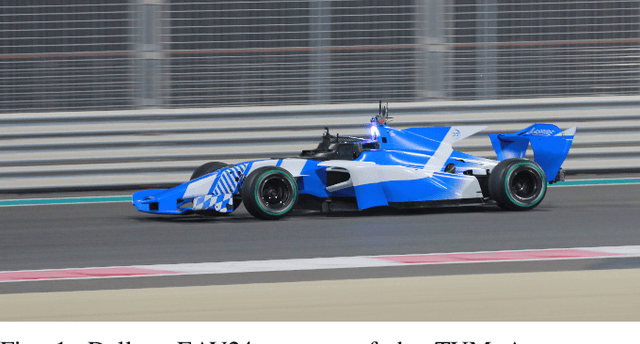
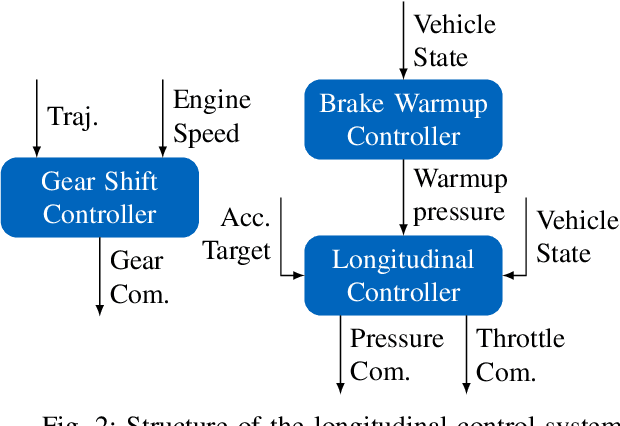
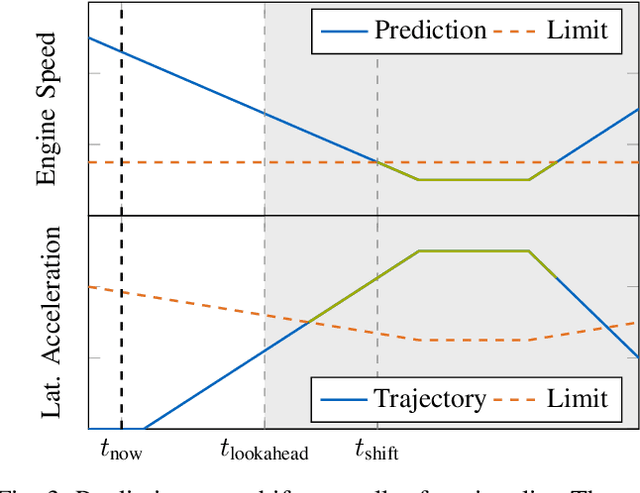
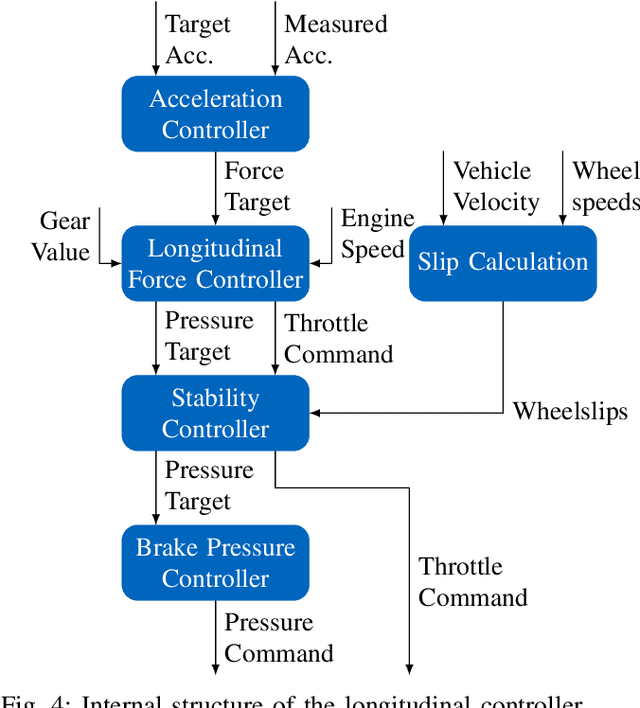
Abstract:Usually, a controller for path- or trajectory tracking is employed in autonomous driving. Typically, these controllers generate high-level commands like longitudinal acceleration or force. However, vehicles with combustion engines expect different actuation inputs. This paper proposes a longitudinal control concept that translates high-level trajectory-tracking commands to the required low-level vehicle commands such as throttle, brake pressure and a desired gear. We chose a modular structure to easily integrate different trajectory-tracking control algorithms and vehicles. The proposed control concept enables a close tracking of the high-level control command. An anti-lock braking system, traction control, and brake warmup control also ensure a safe operation during real-world tests. We provide experimental validation of our concept using real world data with longitudinal accelerations reaching up to $25 \, \frac{\mathrm{m}}{\mathrm{s}^2}$. The experiments were conducted using the EAV24 racecar during the first event of the Abu Dhabi Autonomous Racing League on the Yas Marina Formula 1 Circuit.
Approaching Current Challenges in Developing a Software Stack for Fully Autonomous Driving
Apr 17, 2025Abstract:Autonomous driving is a complex undertaking. A common approach is to break down the driving task into individual subtasks through modularization. These sub-modules are usually developed and published separately. However, if these individually developed algorithms have to be combined again to form a full-stack autonomous driving software, this poses particular challenges. Drawing upon our practical experience in developing the software of TUM Autonomous Motorsport, we have identified and derived these challenges in developing an autonomous driving software stack within a scientific environment. We do not focus on the specific challenges of individual algorithms but on the general difficulties that arise when deploying research algorithms on real-world test vehicles. To overcome these challenges, we introduce strategies that have been effective in our development approach. We additionally provide open-source implementations that enable these concepts on GitHub. As a result, this paper's contributions will simplify future full-stack autonomous driving projects, which are essential for a thorough evaluation of the individual algorithms.
GripMap: An Efficient, Spatially Resolved Constraint Framework for Offline and Online Trajectory Planning in Autonomous Racing
Apr 16, 2025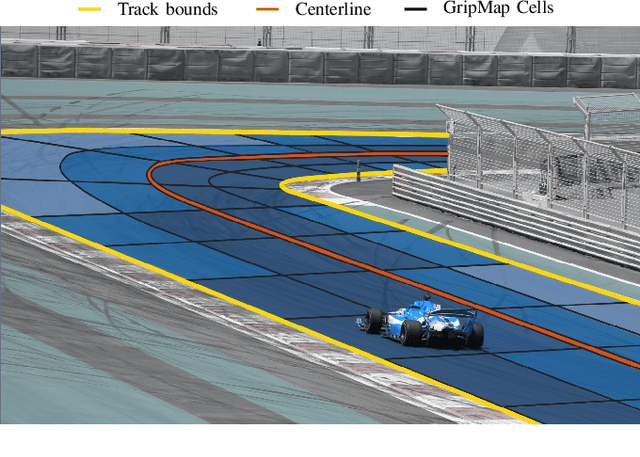
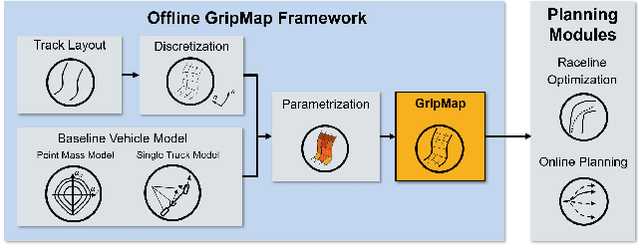


Abstract:Conventional trajectory planning approaches for autonomous vehicles often assume a fixed vehicle model that remains constant regardless of the vehicle's location. This overlooks the critical fact that the tires and the surface are the two force-transmitting partners in vehicle dynamics; while the tires stay with the vehicle, surface conditions vary with location. Recognizing these challenges, this paper presents a novel framework for spatially resolving dynamic constraints in both offline and online planning algorithms applied to autonomous racing. We introduce the GripMap concept, which provides a spatial resolution of vehicle dynamic constraints in the Frenet frame, allowing adaptation to locally varying grip conditions. This enables compensation for location-specific effects, more efficient vehicle behavior, and increased safety, unattainable with spatially invariant vehicle models. The focus is on low storage demand and quick access through perfect hashing. This framework proved advantageous in real-world applications in the presented form. Experiments inspired by autonomous racing demonstrate its effectiveness. In future work, this framework can serve as a foundational layer for developing future interpretable learning algorithms that adjust to varying grip conditions in real-time.
 Add to Chrome
Add to Chrome Add to Firefox
Add to Firefox Add to Edge
Add to Edge